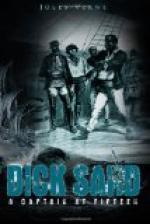In fact it was there. It was that country which Cameron on the south and Stanley on the north were going to cross a few years later, and at the price of what efforts! Of this vast territory, which is composed of three provinces, Benguela, Congo, and Angola, there was but little known then except the coast. It extends from the Nourse, in the south, as far as the Zaire in the north, and the two principal towns form two ports, Benguela and St. Paul’ de Loanda, the capital of the colony which set off from the kingdom of Portugal.
In the interior this country was then almost unknown. Few travelers had dared to venture there. A pernicious climate, warm and damp lands, which engender fevers, barbarous natives, some of whom are still cannibals, a permanent state of war between tribes, the slave-traders’ suspicion of every stranger who seeks to discover the secrets of their infamous commerce; such are the difficulties to surmount, the dangers to overcome in this province of Angola, one of the most dangerous of equatorial Africa.
Tuckey, in 1816, had ascended the Congo beyond the Yellala Falls; but over an extent of two hundred miles at the most. This simple halting-place could not give a definite knowledge of the country, and nevertheless, it had caused the death of the greater part of the savants and officers who composed the expedition. Thirty-seven years later, Dr. Livingstone had advanced from the Cape of Good Hope as far as the upper Zambesi. Thence, in the month of November, with a hardihood which has never been surpassed, he traversed Africa from the south to the northwest, cleared the Coango, one of the branches of the Congo, and on the 31st of May, 1854, arrived at St. Paul de Loanda. It was the first view in the unknown of the great Portuguese Colony.
Eighteen years after, two daring discoverers crossed Africa from the east to the west, and arrived, one south, the other north, of Angola, after unheard-of difficulties.
The first, according to the date, was a lieutenant in the English navy, Verney-Howet Cameron. In 1872, there was reason to fear that the expedition of the American, Stanley, was in great danger. It had been sent to the great lake region in search of Livingstone. Lieutenant Cameron offered to go over the same road.
The offer was accepted. Cameron, accompanied by Dr. Dillon, Lieutenant Cecil Murphy and Robert Moffat, a nephew of Livingstone, started from Zanzibar. After having crossed Ougogo, he met Livingstone’s faithful servants carrying their master’s body to the eastern coast. He continued his route to the west, with the unconquerable desire to pass from one coast to the other.
He crossed Ounyanyembe, Ougounda, and Kahouele, where he collected the great traveler’s papers. Having passed over Tanganyika, and the Bambarre mountains, he reached Loualaba, but could not descend its course. After having visited all the provinces devastated by war and depopulated by the slave trade, Kilemmba, Ouroua, the sources of the Lomane, Oulouda, Lovale, and having crossed the Coanza and the immense forests in which Harris has just entrapped Dick Sand and his companions, the energetic Cameron finally perceived the Atlantic Ocean and arrived at Saint Philip of Benguela. This journey of three years and four months had cost the lives of his two companions, Dr. Dillon and Robert Moffat.




